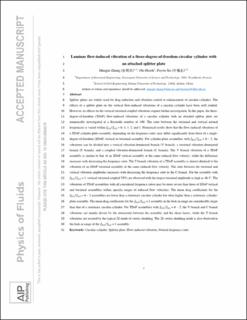| dc.description.abstract | Splitter plates are widely used for drag reduction and vibration control or enhancement of circular cylinders. The effects of a splitter plate on the vertical flow-induced vibrations of a circular cylinder have been well studied. However, its effects on the vertical-torsional coupled vibrations require further investigation. In this paper, the three-degree-of-freedom (TDoF) flow-induced vibrations of a circular cylinder with an attached splitter plate are numerically investigated at a Reynolds number of 100. The ratio between the torsional and vertical natural frequencies is varied within 𝑓𝜃,0/𝑓ℎ,0 = 6, 4, 3, 2, and 1. Numerical results show that the flow-induced vibrations of a TDoF cylinder-plate assembly, depending on the frequency ratio, may differ significantly from those of a single-degree-of-freedom (SDoF) vertical or torsional assembly. For cylinder-plate assemblies with 𝑓𝜃,0/𝑓ℎ,0 = 6–2, the vibrations can be divided into a vertical vibration-dominated branch (V branch), a torsional vibration-dominated branch (T branch), and a coupled vibration-dominated branch (C branch). The V branch vibration of a TDoF assembly is similar to that of an SDoF vertical assembly at the same reduced flow velocity, while the difference increases with decreasing the frequency ratio. The T branch vibration of a TDoF assembly is almost identical to the vibration of an SDoF torsional assembly at the same reduced flow velocity. The ratio between the torsional and vertical vibration amplitudes increases with decreasing the frequency ratio in the C branch. For the assembly with 𝑓𝜃,0/𝑓ℎ,0 = 1, vertical-torsional coupled vortex-induced vibrations are observed with the largest torsional amplitude as high as 46.3°. The vibrations of TDoF assemblies with all considered frequency ratios may be more severe than those of SDoF vertical and torsional assemblies within specific ranges of reduced flow velocities. The mean drag coefficients for the 𝑓𝜃,0/𝑓ℎ,0 = 6–2 assemblies are lower than a stationary circular cylinder but often higher than a stationary cylinder-plate assembly. The mean drag coefficients for the 𝑓𝜃,0/𝑓ℎ,0 = 1 assembly in the lock-in range are considerably larger than that of a stationary circular cylinder. For TDoF assemblies with 𝑓𝜃,0/𝑓ℎ,0 = 6–2, the V branch and C branch vibrations are mainly driven by the interaction between the assembly and the shear layers, while the T branch vibrations are excited by the typical 2S mode of vortex shedding. The 2S vortex shedding mode is also observed in the lock-in range of the 𝑓𝜃,0/𝑓ℎ,0 = 1 assembly. | en_US |
